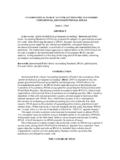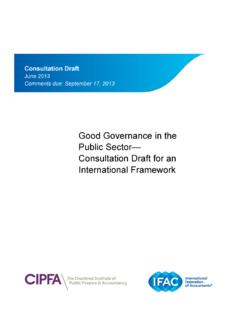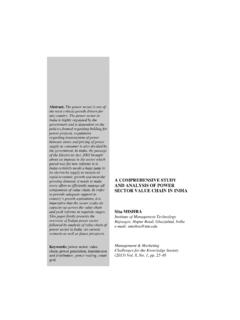Transcription of Mass Casualty Management - WHO
1 mass Casualty Management SystemsStrategies and guidelines for building health sector capacityWorld health Organization20 Avenue Appia, 1211 Geneva 27, SwitzerlandFax: +41 22 791 4844 Email: Action in Crises Injuries and Violence PreventionISBN 978 92 4 159605 3 131/10/2007 09:09:3531/10/2007 09:09:35 mass Casualty Management Systems Strategies and guidelines for building health sector capacityWorld health organization health Action in Crises Injuries and Violence Prevention 6 | mass Casualty MANAGEMENTSYSTEMSS trategies and guidelinesfor building health sector capacityHealth Action in CrisesInjuries and Violence PreventionWHO Library Cataloguing-in-Publication Data : mass Casualty Management systems : strategies and guidelines for building health sector planning - organization and administration.
2 Medical services - methods. medi-cal services - organization and administration. policy. health 978 92 4 159605 3 (NLM classifi cation: WX 185) world health organization 2007 All rights reserved. Publications of the world health organization can be obtained from WHO Press, world health organization , 20 Avenue Appia, 1211 Geneva 27, Switzerland (tel.: +41 22 791 3264; fax: +41 22 791 4857; e-mail: Requests for permission to reproduce or translate WHO publications whether for sale or for noncommercial distribution should be addressed to WHO Press, at the above address (fax: +41 22 791 4806; e-mail: The designations employed and the presentation of the material in this publication do not imply the expression of any opinion whatsoever on the part of the world health organization concerning the legal status of any country, territory, city or area or of its authorities, or concerning the delimitation of its frontiers or boundaries.))
3 Dotted lines on maps represent approximate border lines for which there may not yet be full mention of specifi c companies or of certain manufacturers products does not imply that they are endorsed or recom-mended by the world health organization in preference to others of a similar nature that are not mentioned. Errors and omissions excepted, the names of proprietary products are distinguished by initial capital reasonable precautions have been taken by the world health organization to verify the information contained in this publication. However, the published material is being distributed without warranty of any kind, either expressed or implied. The responsibility for the interpretation and use of the material lies with the reader. In no event shall the world health organization be liable for damages arising from its use. Printed by the WHO Document Production Services, Geneva, SwitzerlandWorld health organization health Action in Crises Injuries and Violence Prevention mass Casualty Management Systems Strategies and guidelines for building health sector capacity| 1 TABLE OF CONTENTSA cknowledgements.
4 2 Foreword .. 3 Abbreviations and acronyms .. 4A note to readers .. 5 Preamble: mass Casualty Management planning concept within the wider health sector emergency Management .. 7 Introduction .. 9 Scope and purpose of these Guidelines .. 9 Why preparedness is a growing priority ..10 WHO policy on emergency preparedness .. 10 Guiding principles .. 11 mass Casualty Management : a key component of national emergency system .. 13A complex partnership ..13 The Ministry of health : a leading partner ..14 Planning for mass Casualty Management at national level ..16 Establishing a baseline .. 16 Hazard analysis and risk assessment ..16 Developing a national mass Casualty Management plan ..17 Training guidelines and standards ..18 Monitoring, surveillance and early warning ..19 Financial and material resources .. 20 Provincial or state (intermediate) level.
5 20 Community and local government level .. 21 Planning and organization .. 21A culture of community preparedness .. 23 Managing mass fatalities .. 24 Communications planning .. 24 health care facility level .. 25 Planning .. 25 Emergency and trauma care systems .. 27 Training and exercises .. 27 Communications .. 28 Check-list: elements to be considered by a health care facilityin developing a mass Casualty Management plan .. 29 Glossary of terms .. 30 Sources of information .. 32 List of Participants .. 33 mass Casualty Management Systems Strategies and guidelines for building health sector capacityWorld health organization health Action in Crises Injuries and Violence Prevention 2 |ACKNOWLEDGEMENTSThe world health organization acknowledges with thanks all participants in the workshop that gave rise to these Guidelines.
6 They are: Dudley McArdle, Marcel Dubouloz, Raed Arafat, Barbara A. Butcher, Teodoro Javier Herbosa, Richard Hunt, Manjul Joshipura, Jan Karlson, Ann R. Knebel, William H. Lyerly, Adelheid Marschang, Charles Mock, Farzad Panahi, Howie Prince, Jeff Runge, Scott Sasser, Firas A. Ta wfi q, Kevin are due to the following reviewers: Pascal Cassan, Jeffrey Hammond, Francesco Della Corte, Betsy Weiner, Ron van Konkelenberg, Peter Koob, and to Andrew Wilson for technically editing the are also due to the WHO staff who supervised, contributed to and coordinated the development and the production of the also thanks the Governments of Norway and Sweden and the United States Centers for Disease Control and Prevention for their generous support of this health organization health Action in Crises Injuries and Violence Prevention mass Casualty Management Systems Strategies and guidelines for building health sector capacity| 3 FOREWORDM ajor emergencies, crises and disasters have become more frequent during recent decades, especially in middle and low income countries.
7 They affect more and more people, disrupting health sector programmes and essential services, and slowing the process of sustainable human development. Many lives could be saved if the affected communities were better prepared, with an organized scalable response system already in place. In addition, survivors of mass Casualty incidents often suffer disabilities or health impairment physical or psychological. These can severely strain the health sector and draw scarce resources away from other essential programmes. Again, much of this is shows that the community is the fi rst to provide emergency assistance in such incidents. For this reason, preparedness planning increasingly emphasizes building capacity (human, organizational and infrastructural) at the community level. Empowering communities to develop emergency Management plans for mass Casualty incidents requires strong involvement by health authorities at all levels, especially the national level, as well as support from other sectors.
8 The common gaps in health system preparedness around the world are generally well understood, but they are often not addressed in a comprehensive and systematic way. In particular, many countries have not yet developed mass Casualty Management Plans, and communities are too often left alone to develop preparedness and response plans without guidance from higher September 2006, a Global Consultation on mass Casualty Management was held in Geneva at WHO headquarters. The Guidelines set out in this document are the direct result of the consultation. They are designed to help policy makers, decision makers and emergency managers at all levels, especially at community level, to overcome the gaps in health system preparedness for managing mass Casualty Casualty Management Systems Strategies and guidelines for building health sector capacityWorld health organization health Action in Crises Injuries and Violence Prevention 4 |CCC Command, control, and coordinationCDC Centers for Disease ControlCERT Community Emergency Response Team (Australia)CRED Centre for Research on the Epidemiology of DisastersCWTC Citizens Welfare Training Course (Philippines)
9 ED Emergency DepartmentEMS Emergency Medical SystemHAC health Action in CrisesHazmat Hazardous MaterialHCF health Care FacilityGIS Geographical Information SystemMCM mass Casualty managementMOU Memorandum of UnderstandingNGO Non-Governmental OrganizationRAV Rural Ambulance Victoria (Australia)ROTC Reserved Offi cers Training Course SAR Search and RescueSOPs Standard Operating ProceduresSERPs Supplemental Emergency Response PlansTCS Trauma Care SystemsWHA world health AssemblyWHO world health OrganizationABBREVIATIONS AND ACRONYMSW orld health organization health Action in Crises Injuries and Violence Prevention mass Casualty Management Systems Strategies and guidelines for building health sector capacity| 5A NOTE TO READERSW hile this document contains a Glossary of Defi nitions, three key terms must be understood from the outset.
10 First, Ministry of health , much of information in these Guidelines deals with the role of a country s supreme health authority usually the Ministry of health in mass Casualty Management . However, in many countries, much or all of the responsibility for organizing the response to emergencies is in the hands of organizations other than the Ministry of health . For example, some countries have separate ministries for emergency situations, while in others the Ministry of Interior or specially mandated agencies may have this role. These Guidelines, should therefore be interpreted and adapted according to the offi cial structures and organizational realities in each , we have used the phrase provincial or state to denote levels of government organization between the national and the local levels. (We have reserved the term regional to apply to international regions according to WHO designations: Africa, the Americas, Eastern Mediterranean, Europe, South East Asia, and Western Pacifi c.)
















